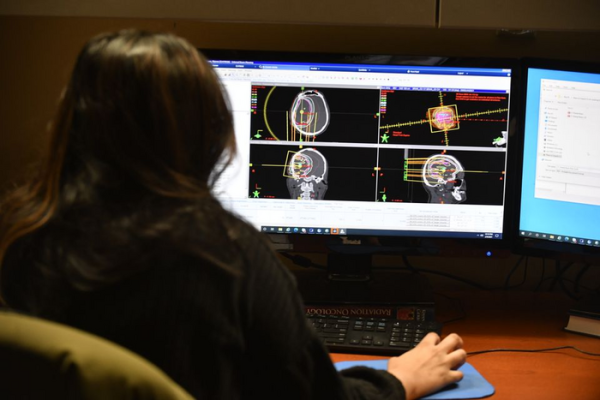
Software enabling work-from-home radiologists to choose which non-emergency scans they read and report on can lengthen turnaround times for lower-priority images, according to new West Virginia University research. Those delays prevent hospital beds from being cleared and reassigned, increasing hospital costs and patient dissatisfaction. Image courtesy of WVU Photo/Brian Persinger
May 17, 2023 — Online workflow systems for off-site radiologists are one reason for health care delays that cost hospitals money and test the patience of patients, according to West Virginia University research.
Bernardo Quiroga, associate professor of supply chain management at the WVU John Chambers College of Business and Economics, and his coauthors analyzed a radiology workflow platform, used by thousands of U.S. hospitals, which allows radiologists working from home to log in, view a pool of tasks such as X-rays or CT and MRI scans that are available for processing, and choose which of those radiological studies to read and report on.
The radiologists’ choices were based on the studies’ priority levels and what they perceived each study’s ratio of pay-to-workload to be — “how financially attractive the job is relative to the labor involved, or the job’s ‘bang for the buck,’” Quiroga said.
The researchers found radiologists chose to work on lower-priority studies offering more bang for the buck when higher-priority studies with less bang for the buck were available — choices that, in aggregate, led to delays for higher-priority cases. Their findings are in the Journal of Operations Management.
Quiroga emphasized the data doesn’t suggest radiologists are putting medically urgent scans on the back burner. They tend to neglect studies with medium-level “administrative” and “operational” priorities, not studies with high clinical priority.
Even so, the longer turnaround times created by this kind of poorly calibrated compensation scheme can delay results and patient admissions.
“Hospitals accrue direct costs by not having results available as soon as possible,” Quiroga said. “However, the significant patient dissatisfaction that also arises from that delay is especially pertinent under Medicare’s Value-Based Purchasing Program, which makes patient satisfaction scores critical to hospitals’ revenues.”
Remote radiologists have been around for decades. Providers send scans off-site to get time-sensitive images processed overnight or to fill gaps at short-staffed rural hospitals.
While radiologists working in hospitals are typically salaried, Quiroga explained those working remotely often earn money via a “piece-rate compensation scheme, in which they’re paid for each task regardless of how long it takes. Piece-rate compensation can be good for worker productivity and worker earnings – but only if the scheme is set up correctly. Determining the right rate for a job can be a tricky task with serious negative repercussions if mishandled.”
Radiologists whose compensation is piece-rate typically meet annual productivity targets, with bonuses for exceeding those targets. The amount a radiologist can earn from each study is expressed in terms of an RVU, or “relative value unit.” That’s a reimbursement amount set by the Centers for Medicare and Medicaid Services; the value of one RVU in 2022 was $33.59.
“In recent years, a strong drive towards evaluating radiologists’ efficiency in terms of their daily RVU output has generated considerable criticism from the radiology community, which says those metrics lead to an unhealthy work environment and increase mistakes,” Quiroga said. “On top of that, imbalances between Medicare and Medicaid pay rates for tasks performed and the actual workloads involved in those tasks have been the subject of extensive discussion within the medical community and especially radiology.
“This research provides evidence that an intense focus on productivity as driven by the RVU may have unintended negative consequences on the level of service radiologists provide to hospitals — and ultimately to patients.”
The dataset for the research comprised more than 2.1 million studies spanning 251 procedures from 62 hospitals, read by 115 radiologists. The hospitals had assigned each study a priority, ranging from “hyperacute,” requiring immediate attention because a patient’s life was in danger, to “routine,” indicating no urgency.
“The two priority levels between ‘hyperacute’ and ‘routine’ are ‘stat’ and ‘expedited,’” Quiroga said. “Almost two-thirds of our database was stat studies: conditions that are medically acute but not life-threatening. Once all hyperacute studies have been completed, stat studies need to be read ASAP.”
On the other hand, expedited studies, like routine ones, have the lowest clinical urgency. They do have operational urgency, though. If a patient is waiting on radiology in order to be discharged, their study might be prioritized as expedited because another patient needs the bed.
“We discovered that the expedited priority class contained the highest percentage of delayed studies, and those delays could be quite large,” Quiroga said. “The workflow platform provider is contractually bound to achieve a certain level of turnaround time, so delay is an important performance measure.”
The root of the problem within the radiology workflow platform driving these delays is likely badly calculated RVUs that don’t reflect the real time and effort tasks take. But realigning that system would be so costly that Quiroga suggests different countermeasures, including selectively limiting the studies available to radiologists.
“A workflow platform could hide some routine procedures with high ‘bang for the buck’ when those studies are still far from their target turnaround times but expedited studies are about to hit their deadlines,” he said. “That approach takes advantage of the platform’s centralized nature and would be invisible to the radiologists. And, as long as the functionality is well-designed, that solution would be essentially costless.”
For more information: https://www.wvu.edu/
Related Telemedicine Coverage:
When Telemedicine Isn’t the Solution
VIDEO: The New Normal of Home Workstations, Teleradiology and Remote Reading
Telemedicine During COVID-19: Video vs. Phone Visits and the Digital Divide
California Physicians Weigh In On Telemedicine
Just Consider the Possibilities


 November 19, 2024
November 19, 2024 








